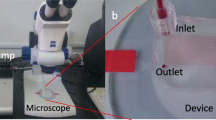Abstract
We investigated the applicability of two non-Newtonian constitutive models (Casson and Herschel-Bulkley models) in the determination of the blood viscosity and yield stress using a pressure-scanning microfluidic hemorheometer. The present results were compared with the measurements through a precision rheometer (ARES2). For a Newtonian fluid (standard oil), the two constitutive models showed excellent agreement with a reference value and the measurement of ARES2. For human blood as a non-Newtonian fluid, both the Casson and Herschel-Bulkley models exhibited similar viscosity results over a range of shear rates and showed excellent agreement with the ARES2 results. The Herschel-Bulkley model yielded a slightly higher value than other results at low shear rates (\( \dot \gamma \) < 10), which may be due to the relatively high value of the yield stress. The yield stress values for whole blood were 14.4 mPa for the Casson model and 32.5 mPa for the Herschel-Bulkley model, respectively. Thus, the present study showed that the Casson model would be better than the Herschel-Bulkley model for representing the non-Newtonian characteristics of blood viscosity.
Similar content being viewed by others
References
Baskurt, O.K., M. Boynard, G.C. Cokelet, P. Connes, B.M. Cooke, S. Forconi, F. Liao, M.R. Hardeman, F. Jung, H.J. Meiselman, G. Nash, N. Nemeth, B. Neu, B. Sandhagen, S. Shin, G. Thurston, and J.L. Wautier, 2009, New guidelines for hemorheological laboratory techniques, Clinical Hemorheol. Microcirc. 42, 75–97.
Charm, S. E. and G. S. Kurland, 1967, Static method for determining blood yield stress, Nature 216, 1121–1123
Chien S., 1970, Shear dependence of effective cell volume as a determinant of blood viscosity, Science 168, 977–979.
Ferguson J. and Z. Kemblowski, 1991, Applied Fluid Rheology, Elsevier, London.
Fossum, E., A. Hoieggen, and A. Moan, 1997, Whole blood viscosity, blood pressure and cardiovascular risk factors in healthy blood donors, Blood Pressure 6, 161–165.
Fung, Y. C., 1987, Biomechanics-Mechanical Properties of Living Tissues, Springer, New York, 62–100
Kim S., Y. I. Cho, W. N. Hogenauer, and K. R. Kensey, 2002, A method of isolating surface tension and yield stress effects in a U-shaped scanning capillary-tube viscometer using a casson model, J. Non-Newtonian Fluid Mech 103, 205–219.
Kim, S., Y. I. Cho, A. H. Jeon, B. Hogenauer, and K. R. Kensey, 2000, A new method for blood viscosity measurement, J. Non-Newtonian Fluid Mech 94, 47–56.
S. Kim, B. Namgung, P. K. Ong, Y. I. Cho, K. J. Chun, and D. Lim, 2009, Determination of rheological properties of whole blood with a scanning capillary-tube rheometer using constitutive models, J. Mechanical Science and Technology 23, 1718–1722.
Ogawa, K., S. Okawara, S. Ito, and K. Taniguchi, 1991, Blood viscometer with vacuum glass suction tube and needle, J. Chemical Eng. of Japan 24, 215–221.
C. Picart, J. M. Piau, and H. Galliard, 1998, Human blood shear yield stress and its hematocrit dependence, J. Rheol. 42, 1–12.
Picart C., P.H. Carpentier, H. Galliard, and J.M. Piau, 1999, Blood yield stress in systemic sclerosis. Am. J. Physiol. 276, H771–H777.
Reinhart, W.H., A. Haeberli, J. Stark, and P.W. Straub, 1990, Influence of blood withdrawal and anticoagulant on clotting activity, hematologic data, and certain rheologic measurements, J. Lab. Clinical Med 115, 98–103.
Shin, S., D.Y. Keum, and Y.H. Ku, 2002, Blood viscosity measurement using a pressure-scanning capillary viscometer, KSME Int. J 16, 1719–1724.
Shin, S., J.X. Hou, J.S. Suh, and M. Singh, 2007, Validation and application of a microfluidic ektacytometer (RheoScan-D) in measuring erythrocyte deformability, Clinical Hemorheol. Microcirc. 37, 319–328.
Sun, N. and D. De Kee, 2001, Simple shear, hysteresis and yield stress in biofluids, Can. J. Chem. Eng. 79, 36–41.
Yilmaz F. and M.Y. Gundongdu, 2008, A critical review on blood flow in large arteries; relevance to blood rheology, viscosity models, and physiologic conditions, J. Korea-Australia Rheol. 20, 197–211
Zydney, A. L., J. D. Oliver, and C. K. Colton, 1991, A constitutive equation for the viscosity of stored red blood cell suspensions: effect of hematocrit, shear rate, and suspending phase, J. Rheol. 35, 1639–1680.
Author information
Authors and Affiliations
Corresponding author
Rights and permissions
About this article
Cite this article
Lee, BK., Xue, S., Nam, J. et al. Determination of the blood viscosity and yield stress with a pressure-scanning capillary hemorheometer using constitutive models. Korea-Aust. Rheol. J. 23, 1–6 (2011). https://doi.org/10.1007/s13367-011-0001-y
Received:
Revised:
Accepted:
Published:
Issue Date:
DOI: https://doi.org/10.1007/s13367-011-0001-y




